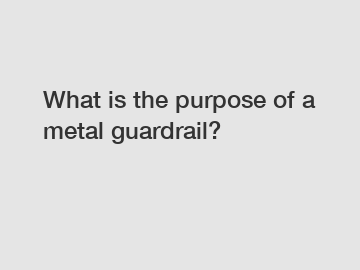What is the purpose of a metal guardrail?
What is the Purpose of a Metal Guardrail?
A metal guardrail is an essential safety measure used in various settings to prevent accidents and injuries. It is typically used along highways, roads, bridges, and other locations where there is a risk of vehicles veering off the road or pedestrians falling from elevated areas. The primary purpose of a metal guardrail is to provide a protective barrier that redirects vehicles back onto the road, absorbs impact energy, and minimizes the severity of accidents. In this article, we will explore the different uses and benefits of metal guardrails.
Preventing Vehicles from Veering Off the Road.

One of the main purposes of a metal guardrail is to prevent vehicles from veering off the road or crossing into opposing traffic. By acting as a physical barrier, a guardrail ensures that vehicles stay within their designated lanes, reducing the risk of head-on collisions and potential fatalities. It is particularly crucial on sharp curves and areas prone to hazardous driving conditions, where vehicles are more likely to lose control.
Absorbing Impact Energy and Minimizing Severity of Accidents.
When a vehicle collides with a guardrail, the impact energy is absorbed and dissipated throughout the guardrail structure. This reduces the force of the impact on the vehicle occupants, minimizes the severity of injuries, and prevents the vehicle from continuing its path of destruction. The guardrail acts as a cushion, allowing the vehicle to come to a controlled stop rather than crashing into other objects or going off the road.
Protecting Pedestrians and Cyclists.
Metal guardrails are not limited to protecting vehicles; they also play a crucial role in safeguarding pedestrians and cyclists. Along sidewalks, footbridges, or paths near roads, guardrails serve as a protective barrier, preventing accidental falls and providing a sense of security for those on foot or bicycles. This is especially important in areas where there are significant height differences or potential hazards.
Channeling Traffic Flow and Enhancing Road Safety.
In addition to their primary safety function, metal guardrails also help in channeling traffic flow and ensuring road safety. By separating opposing lanes and guiding vehicles along specific routes, guardrails contribute to the overall organization and orderliness of the road. This promotes smoother traffic flows, reduces the likelihood of collisions, and enhances the overall safety of everyone on the road.
Durability and Cost-Effectiveness.
Metal guardrails are often chosen over other barrier materials due to their durability and cost-effectiveness. They are designed to withstand various weather conditions, including extreme temperatures, strong winds, and heavy rainfall. Moreover, they require minimal maintenance compared to alternatives such as concrete or wooden barriers. Metal guardrails are long-lasting, providing a reliable safety solution that minimizes the need for frequent repairs or replacements.
Conclusion.
Metal guardrails serve a vital purpose in ensuring road and pedestrian safety. By preventing vehicles from veering off the road, absorbing impact energy, protecting pedestrians, and channeling traffic flow, they play a significant role in reducing accidents and minimizing the severity of injuries. Furthermore, their durability and cost-effectiveness make them an excellent long-term investment for maintaining safe road infrastructure.
If you require assistance with installing metal guardrails or have any inquiries about their usage, do not hesitate to contact us. Our team of experts is ready to provide advice and guidance to ensure the safety of your roads and pedestrians.
For more How Far is the Spacing of Guardrail Posts, Guard Rail Post Wholesale, How Far is the Spacing of Guardrail Postsinformation, please contact us. We will provide professional answers.


